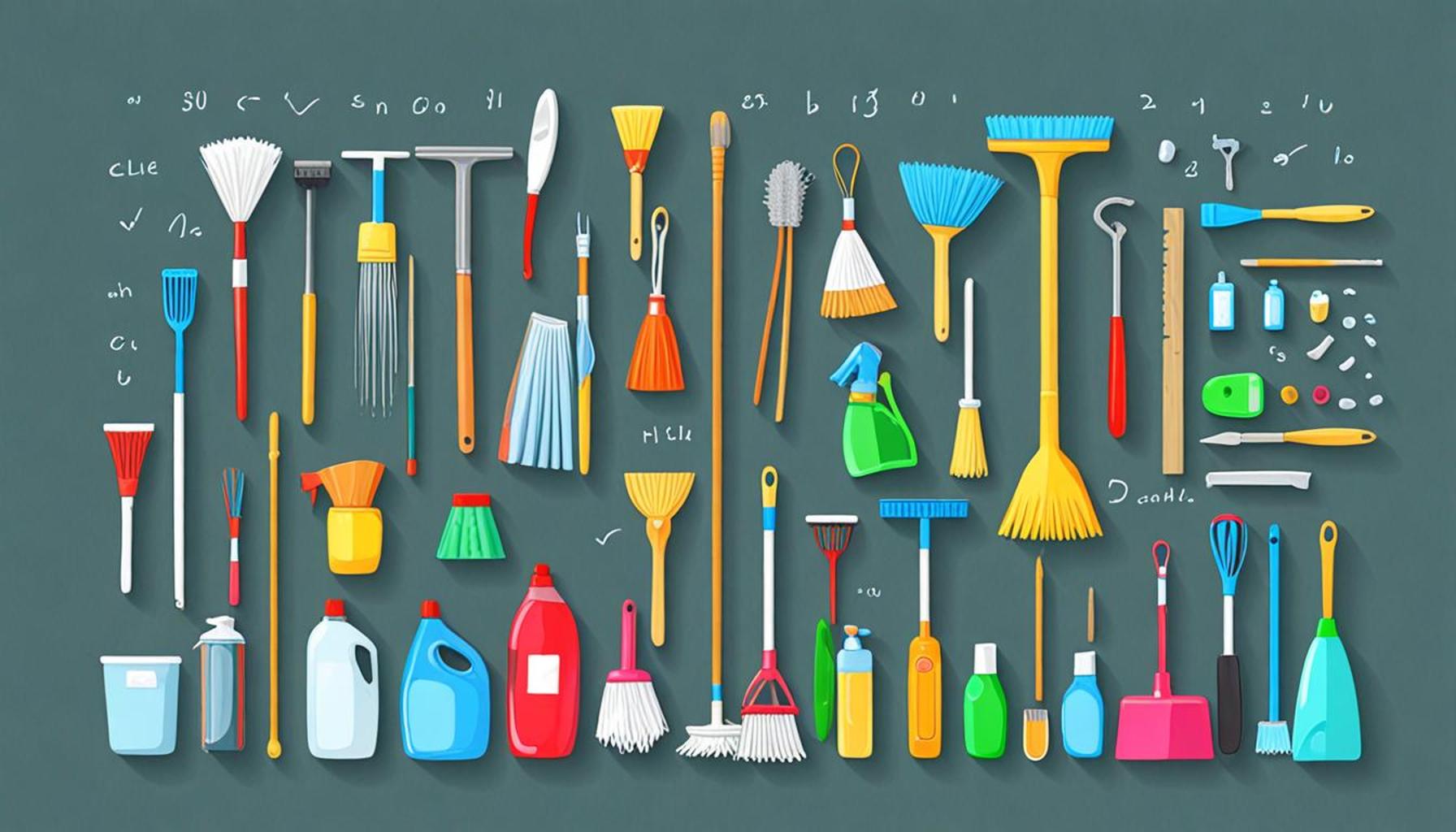How to Involve the Whole Family in a Cleaning Schedule for a Tidy Home

Building Strong Family Ties Through Cleanliness
Creating a harmonious home environment is often linked to maintaining cleanliness. However, keeping a tidy space can feel overwhelming, particularly for busy families juggling various responsibilities. Engaging the whole family in a cleaning schedule not only lightens the load but also fosters essential life skills that your children will carry into adulthood. Beyond practicality, this shared endeavor can transform cleaning from a chore into an enjoyable bonding experience, thereby decreasing stress and enhancing your family’s overall dynamics.
Benefits of a Family Cleaning Schedule
Implementing a family cleaning schedule can yield numerous benefits that extend beyond a clean home:
- Shared Responsibility: When everyone pitches in, it cultivates a sense of teamwork and accountability. For example, when your children see themselves contributing to a shared goal, it encourages cooperation and instills a sense of pride in their contributions.
- Life Skills: Participating in household chores teaches children valuable skills such as organization, time management, and personal hygiene. Young children can learn to sort laundry, while older kids might take on vacuuming or dishwashing, equipping them with practical skills they will use throughout their lives.
- Quality Time: Cleaning as a family allows for meaningful interactions, which can strengthen family connections. For instance, while tidying up the living room, family members might reminisce about favorite movies watched there or recount humorous family stories, deepening their bond.
Getting Started: Tips for Success
To embark on this journey, consider implementing the following strategies:
- Incorporate Age-Appropriate Tasks: Tailor chores to fit each family member’s age and capabilities. For instance, toddlers can help with sorting toys, while pre-teens can handle sweeping or dusting. This ensures that everyone feels included and valued in the household effort.
- Create a Visual Schedule: Develop a chore chart or calendar that is displayed in a common area, like the kitchen or family room. This tool can serve as both a reminder and a source of motivation, while also helping children learn to track their responsibilities.
- Make it Fun: Introduce an element of excitement into mundane tasks by turning them into games or challenges. For example, use a timer to turn cleaning into a race, or offer incentives, like a family movie night or pizza party, as rewards for completing chores. This positive reinforcement motivates participation and creates a positive association with cleaning.
With thoughtful planning and enthusiastic participation, the task of cleaning can evolve into a delightful family affair. As you begin this collective endeavor, you’ll realize that values such as togetherness, responsibility, and cleanliness are not just compatible; they are fundamental to family life and well-being. With every chore completed as a unit, your family can thrive in a more organized and joyful home environment.
DISCOVER MORE: Click here for quick cleaning tips

Creating a Family-Friendly Cleaning Schedule
Establishing a family cleaning schedule might seem like a daunting task, but with the right approach, it can become an integral part of your home’s rhythm. Start by discussing the importance of cleanliness with your family. Explain how a tidy home not only enhances mental well-being but also promotes a healthy lifestyle. Engaging children in this discussion fosters a sense of ownership and encourages them to take responsibility for their living space.
Assessing Your Space and Duties
The first step in crafting a successful cleaning schedule is to take stock of the chores that need to be accomplished in your household. Review common areas like the kitchen, living room, and bathrooms, as well as private spaces such as bedrooms. Next, break down the cleaning duties into manageable categories. Here are some typical tasks you might consider including in your family cleaning schedule:
- Daily Tasks: These activities can involve straightforward chores like making beds, loading the dishwasher, or wiping down counters.
- Weekly Tasks: Tasks such as vacuuming, mopping floors, and cleaning bathrooms typically fall into this category. Assigning these jobs on a weekly basis will ensure a consistent cleaning routine.
- Monthly Deep-Cleaning Tasks: Consider identifying a day at the end of each month for deep cleaning tasks like window washing, organizing closets, or decluttering common spaces.
Engaging Everyone in the Process
After identifying the chores, it’s time to assign tasks. To maintain enthusiasm, involve every family member in the task assignment process. Each person should have a say in the chores they prefer, making sure to align them with their abilities, which is essential for fostering engagement. By rotationally assigning roles, family members won’t feel stuck doing the same job repeatedly, alleviating potential boredom and frustration.
Furthermore, create a fun atmosphere around the assignments. Use engaging language while seeking input from family members. Questions like, “Which day would you like to tackle the living room together?” can make your family feel valued in the decision-making process. Encouraging ownership over their tasks reinforces a culture where everyone contributes to the home’s cleanliness.
Remember, the key to a successful family cleaning schedule lies in flexibility. Life is unpredictable, and schedules may need adjusting from time to time. Regular check-ins can help assess the effectiveness of the assigned tasks and ensure everyone is comfortable with their responsibilities. As you embark on this collaborative effort, you’ll find yourselves not only creating a cleaner home but also strengthening your familial bonds along the way.
Engaging Family Members in the Cleaning Process
Involving the whole family in a cleaning schedule is not merely about assigning chores; it’s about fostering a sense of teamwork and cooperation that can transform the home environment into a more harmonious space. By actively engaging family members in the cleaning process, you not only share the workload but also instill responsibility and the value of a tidy living area.One effective approach is to hold a family meeting to discuss and design the cleaning schedule together. This cultivates ownership and ensures that everyone feels heard and valued. Encourage each member, from kids to adults, to share their preferences regarding tasks they would like to take on. This strategy can lead to a more balanced cleaning load, where tasks align with individual interests and strengths.
Creating a Visual Schedule
Visual aids can reinforce commitment to the cleaning schedule. Consider utilizing a colorful chart or a whiteboard that outlines weekly chores. Include stickers or magnets that family members can use to track their completed tasks. This not only adds an element of fun but also serves as a visual reminder of everyone’s responsibilities.Another idea is to gamify the experience. Introducing friendly competitions can make cleaning activities more enjoyable. For example, who can finish their chores the fastest or who has the cleanest room can be fun challenges that create light-hearted competition and motivate everyone to participate.Finally, make sure to regularly review and adjust the cleaning schedule as needed. Children grow and their capabilities change, while family dynamics can shift based on busy schedules. Being flexible ensures that the system is always adaptable and relevant to your family’s needs. This fluid approach promotes consistency, keeping everyone involved and invested in the cleanliness of the home.
DISCOVER MORE: Click here for tips on organizing your cleaning tools
Motivating the Family to Clean Together
Once you have established a cleaning schedule, the next vital step is to keep your family engaged and motivated. A cleaning routine can easily become mundane if there are no incentives to keep spirits high. Creative strategies can transform cleaning from a dreaded task into an enjoyable family activity. Here are some effective methods to ensure that everyone stays motivated:
Incorporating Gamification
Gamification is an excellent way to make cleaning more fun and competitive. You can create a point system where family members earn points for completing their assigned tasks. For example, making the bed could be worth 5 points, while vacuuming might earn 10 points. At the end of each week or month, tally up the points and offer fun rewards, such as choosing the movie for family movie night or a small treat. This strategy not only fosters a sense of achievement but also encourages family members to complete their chores diligently.
Setting a Timer for Quick Clean-Ups
Time management can transform the perception of cleaning as a time-consuming chore into a quick and efficient effort. Introduce a “15-Minute Tidy” session where everyone pitches in for just 15 minutes to clean specific areas of the house. Set a timer and make it a race against the clock to see how much can be accomplished in that short period. This method can be particularly effective with children, who often respond well to short bursts of activity.
Creating a Cleaning Playlist
Music has a remarkable way of changing our mood and energy levels. Creating a family cleaning playlist filled with upbeat songs can make chores feel less like a burden and more like a fun dance party. Encourage everyone to contribute their favorite songs to the playlist. Whether it’s pop hits, classic rock, or even a little bit of hip-hop, having music in the background can transform the atmosphere and make the cleaning session more enjoyable.
Family Meetings to Review Progress
An essential aspect of keeping everyone involved is regular family meetings to discuss the cleaning schedule and progress. Set aside a time each month to sit down together and discuss what worked well and what could be improved in the cleaning process. Encourage family members to provide their feedback, suggestions, and concerns regarding their assigned tasks. This open communication fosters a supportive environment and reassures everyone that their voices matter.
Incorporating Cleaning into Family Activities
Sometimes, the best way to promote a cleaner home is to incorporate cleaning time into other enjoyable activities. For instance, combine cleaning efforts with family bonding time by making a fun day out of it. Plan a family picnic at a local park after a successful cleaning session, or reward everyone with a game night featuring their favorite board games. This encourages your family to associate cleaning with positive experiences rather than merely a chore that needs to be done.
By implementing these engaging strategies and continuously promoting teamwork, you will foster a cleaning culture in your home where everyone feels valued and accountable for maintaining a tidy environment. Remember, the ultimate goal is to instill a sense of unity and pride in achieving a clean and organized home together. As a result, your family will not only benefit from a more organized space, but also strengthen interpersonal connections that thrive on collaboration and shared responsibilities.
DISCOVER MORE: Click here for tips on an effective cleaning schedule
Conclusion
Involving the whole family in a cleaning schedule is not just about maintaining a tidy home; it’s about fostering a sense of teamwork and accountability among family members. By utilizing strategies such as gamification, timed sessions, and creating an upbeat cleaning playlist, you make the process engaging and enjoyable for everyone. Discussing progress through family meetings is crucial in ensuring that all voices are heard, and incorporating cleaning into fun family activities helps build positive associations around chores.
Ultimately, a successful cleaning routine not only results in a cleaner living space but also strengthens the bonds between family members. It allows each individual to feel a sense of ownership over their environment. As parents and guardians, instilling these habits in children can lead to lifelong skills and a greater appreciation for maintaining order. Moreover, as families take pride in their shared accomplishments, they will naturally cultivate a home that reflects their collective efforts and values.
As you embark on this journey towards a decluttered and organized home, remember that flexibility is key. Adapt the cleaning schedule to suit your family’s evolving needs, and don’t hesitate to experiment with different methods to keep motivation high. With a proactive and collaborative approach, you can transform cleaning from a mundane obligation into a rewarding and harmonious family endeavor.


